| |||||||
| Search Forums |
| Advanced Search |
| Go to Page... |
 |
| Search this Thread |  37,305 views |
| | #1 |
| Distinguished - BHPian  | All about speeding, speed limits, and reasons & methods for setting speed limits We love our cars - and the faster they go, the more we love them. We spend big money to make our cars go faster - and we hate speed limits and the penalties associated with exceeding speed limits. We think we know how fast is safe - and we think the posted speed limits are ridiculously low. But do we understand why and how speed limits are set? What is the logic behind setting a certain speed limit for a particular stretch of road? What factors are taken into account for keeping vehicular speed within a certain limit? And can we drive above / below the speed limit under certain circumstances? |
| |  (38)
Thanks (38)
Thanks
 |
| The following 38 BHPians Thank SS-Traveller for this useful post: | abhishek46, alpha1, ash22, Blooming Flower, chaitanyakrish, cs_rajesh, dailydriver, dealer, digitalnirvana, frewper, Gaboonviper04, GTO, hmansari, IndigoXLGrandDi, J4J, jailbird_fynix, Malyaj, N33raj, nalinsaxena23, Nempuguru, Nitish.arnold, Rehaan, RudiV3810, samaspire, Samba, sayakc, SDP, siddarthab, Sip, tejas2323, Tgo, theexperthand, The_Outsider!, Vasuki, vb-saan, Vik0728, virgopal, xjosephjacob |
| |
| | #2 |
| Distinguished - BHPian  | re: All about speeding, speed limits, and reasons & methods for setting speed limits Definition of Speeding: As defined by the OECD/ECMT Transport Research Centre: Speed Management report, Paris 2006, speeding encompasses excessive speed (driving above the speed limit) or inappropriate speed (driving too fast for the conditions, but within the limits). As well as being a causation factor in around one third of fatal accidents, speed is an aggravating factor in the severity of all accidents. It has also serious consequences on the environment and energy consumption. Speed management can be defined as a set of measures to limit the negative effects of excessive and inappropriate speeds. Not only does this mean measures to restrict speed, but it also includes elements of road design, separation of different types of road users, road markings etc. based on the volume and type of traffic on that particular road. One of the most important aspects of speed management is education of road users, which, sadly, is sorely lacking in India. 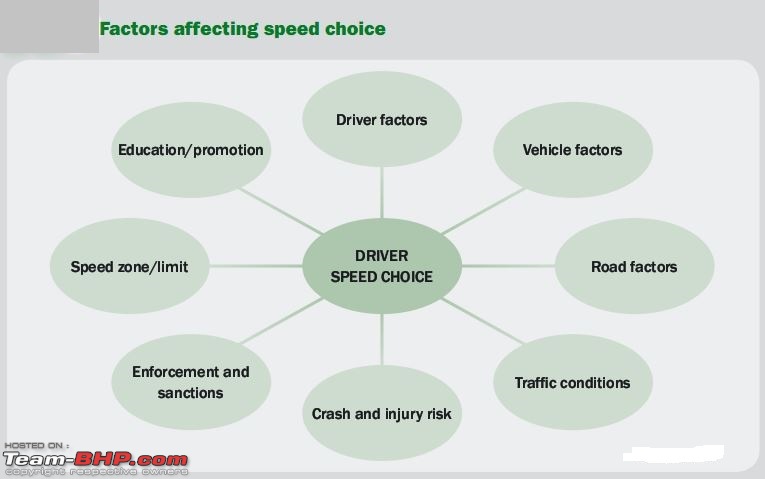 An appropriate speed is a speed level that considers traffic safety as the main goal, in the context of mobility and prevailing conditions such as roadside development, the mix of users along the road, the frequency of access to the road (including intersections), the volume and mix of traffic, environmental concerns and the quality of life for residents living along the road. Last edited by SS-Traveller : 18th October 2019 at 09:56. |
| |  (23)
Thanks (23)
Thanks
 |
| The following 23 BHPians Thank SS-Traveller for this useful post: | Blooming Flower, digitalnirvana, Gaboonviper04, gischethans, glovins2004, GTO, hok kolorob, jailbird_fynix, N33raj, Nempuguru, Rajeevraj, Rehaan, samaspire, Samba, sayakc, SDP, siddarthab, tejas2323, Tgo, theexperthand, vb-saan, Vik0728, virgopal |
| | #3 |
| Distinguished - BHPian  | re: All about speeding, speed limits, and reasons & methods for setting speed limits So how fast can you really drive? And why do we need speed limits? Around the world, including in India, the speeds that vehicles are capable of have increased progressively over the years. Only 30 years ago, there were very few cars capable of crossing the 150 kmph barrier. Today, most of our run-of-the-mill production vehicles are easily capable of crossing that speed. However, what has not changed very radically is the capability of the driver as well as all other road users to adapt / react to these higher speeds. Reaction times have not reduced (as a matter of fact, with growing numbers of in-car distractions such as mobile phones and complex ICE systems, distractions have increased!), and stopping distances have not radically changed since the laws of physics have not changed. In spite of huge improvements made in road and traffic design, vehicular safety, more stringent enforcement and better driver training, many countries across the world see a continuous rise in the number of casualties and deaths year-on-year. Take a look at the graphs below, where India has one of the highest numbers (as well as the fastest rise) of road traffic related deaths in the world - in simple terms, the numbers translate to 3 deaths every 10 minutes.  Source 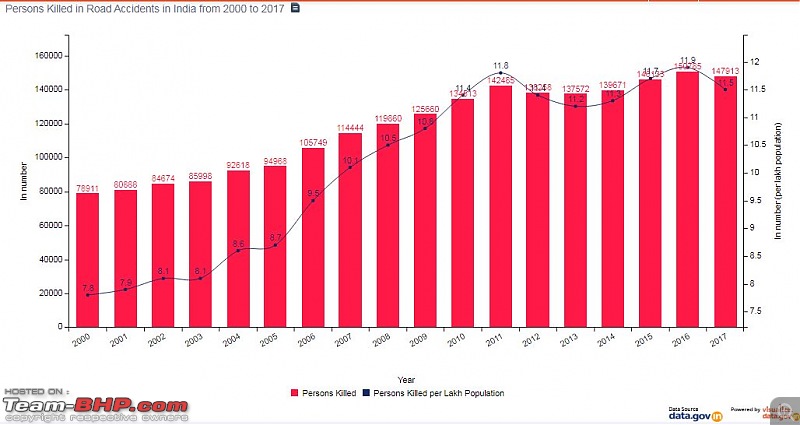 Between 2016 & 2017 the India statistics show a reduction in road-related casualties, but this is a short-term trend worldwide. For 2017, a decrease in the number of road deaths was reported by 20 of 29 member countries of the International Road Traffic Data and Analysis Group (IRTAD) for which preliminary fatality data are available. Four countries saw the number of traffic fatalities remain stable. Only five registered increases of 2% or more in road deaths compared to 2016. The only way that the numbers of such deaths can be kept in check, according to consensus across most countries in the world, is by limiting the maximum speed at which a vehicle can be permitted to travel. Therefore, the national speed limits in most countries across the world range from 80 to 120 kmph, with very few exceptions, where certain roads do not have any speed limit at all.  Source Many governments, including in India, have demonstrated a reluctance to enforce limits effectively, as there is considerable public reaction to such measures. A commitment to support enforcement will be essential to achieving safe travel speeds by drivers. Increasing speed limits by large extents is a known and well-documented cause of increasing crashes and fatalities, and the government can ill-afford to allow this when it is committed on international forums to reduce road fatalities drastically by 2022. Speed limit on Delhi-Meerut Expressway may soon be raised to 120 kmph Research in America examined the effect of changes in speed limits on deaths on rural interstate highways . Road crash deaths in the groups of states that raised their speed limits from 65 to 70–75 mph rose by 38% and 35% respectively, relative to fatality levels in the states that did not change their speed limits. Between 1987 and 1988, 40 states in the USA raised the speed limit on interstate highways from 55 mph (88 kmph) to 65 mph (104 kmph). This resulted in an increase in average car speeds of about 3 mph (5 kmph). Over the same period there was an increase in deaths on these roads of between 20 and 25%. During the 1973 fuel crisis, the New Zealand government reduced rural speed limits from 55 mph (88 kmph) to 50 mph (80 kmph), leading to an 8–10 kmph reduction in average rural speeds. The drop in speed led to a significant drop in injuries, as compared with urban roads which were unaffected by the speed limit change. On main intercity roads the number of deaths dropped by 37%, serious injuries decreased by 24% and minor injuries decreased by 22% . The corresponding reductions for urban areas were 15%, 9% and 4%. In Australia, the speed limit on Melbourne’s rural and outer freeway network was increased from 100 kmph to 110 kmph in 1987 and then changed back to 100 kmph in 1989. Compared to a control area where the speed limit remained the same, the injury crash rate per kilometre travelled increased by 24 .6% when the speed limit increased, and decreased by 19.3% when the speed limit decreased. Once again in Australia - in 2002, the State of Victoria launched their Arrive Alive! Strategy, which also had a strong focus on lowering vehicle speeds. Stronger enforcement and a reduced tolerance margin for speed limit exceedance led to noticeable decreases in the average speed, especially in 60, 70 and 80 km/h zones. During the first four years of the strategy (2002-2005), there was a reduction of around 16% in fatalities. The 43% reduction in fatalities in metropolitan Melbourne from 2001 to 2003 was spread across all road user categories. Even though it is difficult to conclude that the reduction in road trauma was solely due to improved compliance with speed limits, patterns of the injury and fatality reduction suggested that this was a major contributor to the trauma reduction. France. On 14th July 2002 – the national holiday in France – the French President announced that the “fight against road unsafety” would be one of the government's three main objectives for the following five years. A year later, a road safety action plan – which involved several ministries – was adopted which included a strong focus on speed enforcement, with the introduction of automatic enforcement. Over three years from 2002, the average speed on French roads decreased by 5 km/h and fatalities decreased by over 30% in France – an unprecedented result. Last edited by SS-Traveller : 19th October 2019 at 14:06. |
| |  (28)
Thanks (28)
Thanks
 |
| The following 28 BHPians Thank SS-Traveller for this useful post: | alpha1, BlackPearl, Blooming Flower, Burn_out, chaitanyakrish, digitalnirvana, DriverWanderer, GST, GTO, Hayek, jailbird_fynix, N33raj, Nempuguru, Rajeevraj, Raj_RD, RudiV3810, samaspire, Samba, samy1117, sayakc, SDP, sukiwa, tejas2323, Tgo, theexperthand, vb-saan, Vik0728, virgopal |
| | #4 | |
| Distinguished - BHPian  | re: All about speeding, speed limits, and reasons & methods for setting speed limits The advantages and disadvantages of higher speeds, and why speeds should be low in urban areas Advantages • Allows reduction of journey time • Enhances mobility • Caters to driver's adrenalin rush & entertainment (questionable advantage) Disadvantages • Increases the distance travelled before a driver's reaction time + stopping distance can stop a vehicle • Increases fuel consumption • Increases greenhouse gas emissions • Lesser time for both driver and other road users to recognize hazards • Reduced ability of other road users to judge vehicle speed and time before collision • Lesser opportunity for other road users to avoid a collision • Greater likelihood that a driver will lose vehicle control • Adversely impacts quality of life of vulnerable road users But then, you, the individual reader / fast driver, would say: I drive fast but I haven't crashed in 20 years of driving! Read on, then: Quote:
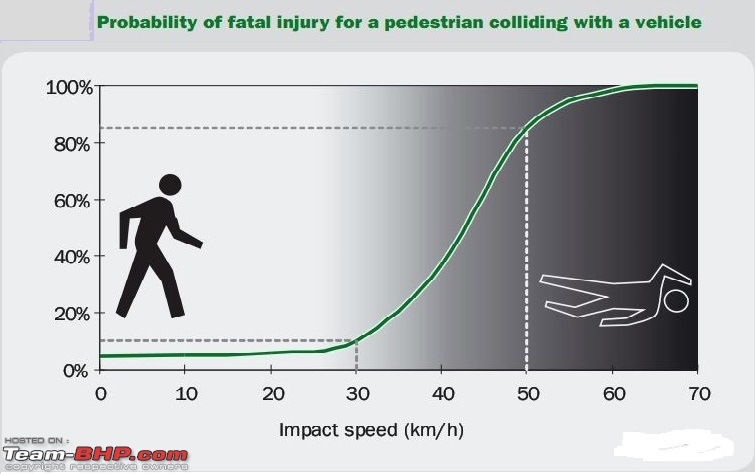 The human tolerance to injury by a car will be exceeded if the vehicle is travelling at more than 30 km/h. Pedestrians, as illustrated above, incur a risk of about 80% of being killed at a collision speed of 50 km/h. Most traffic systems, however, are not designed on the basis of human tolerance. Separating cars and pedestrians by providing footpaths is very often not done. Speed limits of 30 km/h in shared-space residential areas are often not implemented. Historically, car and bus fronts have not been designed to provide protection for pedestrians against injury at collision speeds of 30 km/h or more. Hence, even a 5% lowering of speed reduces the incidence of casualties and fatalities by a much larger percentage (studies indicate a reduction of approximately 20% or more). Therefore, in urban areas with heavy traffic of vulnerable members, it is important to reduce speed below 50 kmph. Speed management is not incompatible with mobility and economic needs. Mathematically, higher speed leads to reduced travel time. However, the effects of speed in reducing travel time are generally overestimated by road users and, at least in urban areas, the time savings are often small or negligible because of intersections and delays at traffic lights. In terms of infrastructure use, reducing the average speed of the flow does not necessarily reduce the throughput capacity of the road. For example, the maximum capacity of an urban expressway is typically obtained at a speed of about 60-70 kmph, and increasing the maximum permissible speed over such stretches does not actually reduce travel time. Last edited by SS-Traveller : 19th October 2019 at 14:27. | |
| |  (23)
Thanks (23)
Thanks
 |
| The following 23 BHPians Thank SS-Traveller for this useful post: | alpha1, BlackPearl, Blooming Flower, digitalnirvana, DriverWanderer, Gaboonviper04, GeeTee TSI, GST, GTO, jailbird_fynix, N33raj, Rajeevraj, Samba, sayakc, siddarthab, sukiwa, tejas2323, Tgo, The Rationalist, theexperthand, vb-saan, Vik0728, virgopal |
| | #5 |
| Distinguished - BHPian  | re: All about speeding, speed limits, and reasons & methods for setting speed limits And how are speed limits set scientifically? The most common method that has been used historically is the 85th percentile speed method. The speeds of all vehicles on a particular stretch of road are mapped, and a graph plotted as below:  Source In the 1960s, limits were set largely to reflect drivers’ behaviour and using the 85th percentile speed – in effect saying drivers were making rational choices and only those in the minority 15% would be judged as ‘speeding’. With increasing speeds of modern cars coupled with better engineering leading to 'speed masking', the judgment of the 85th percentile has become fallacious, and their choice of speed is no longer considered safe. This is especially true in India, where inadequate driver training and education, along with lack of lane discipline while driving, makes increased highway speeds dangerously unsafe. Engineering approach: A two-step process where a base speed limit is set according to the 85th percentile speed and then modified according to the design speed for the road and other criteria. Another alternative for determining deviations from the 85th percentile is the road risk method, which uses the functional classification of the road and its setting to determine base speed. As analyses of crash data reveal a growing speed related problem, lower speed limits are set that take into account road design factors (sight distance, road curvature and so on). Expert systems: Speed limits are set by a computer program / software that uses knowledge and inference procedures that simulate the judgment and behaviour of speed limit experts. Economic trade-off / Optimization Method was then introduced. With cost-benefit analysis of road projects using estimates of the ‘value of time’ savings to justify investment, there was a natural trend towards faster roads. This method is currently not in much use across the world. The Safe System (Harm Minimization) approach: The aim of a safe system is to achieve a road system that allows for human error without leading to death or serious injury. It recognizes the limits of force that the human body can survive and focuses on systematically addressing various factors involved in specific crash types to reduce the risk of injury. Crashes are always likely to happen, even though there is a continuing focus on prevention. The Safe-system approach aims to minimize the severity of injury when a crash occurs and is based on the premise that road users should not die because of system failings. 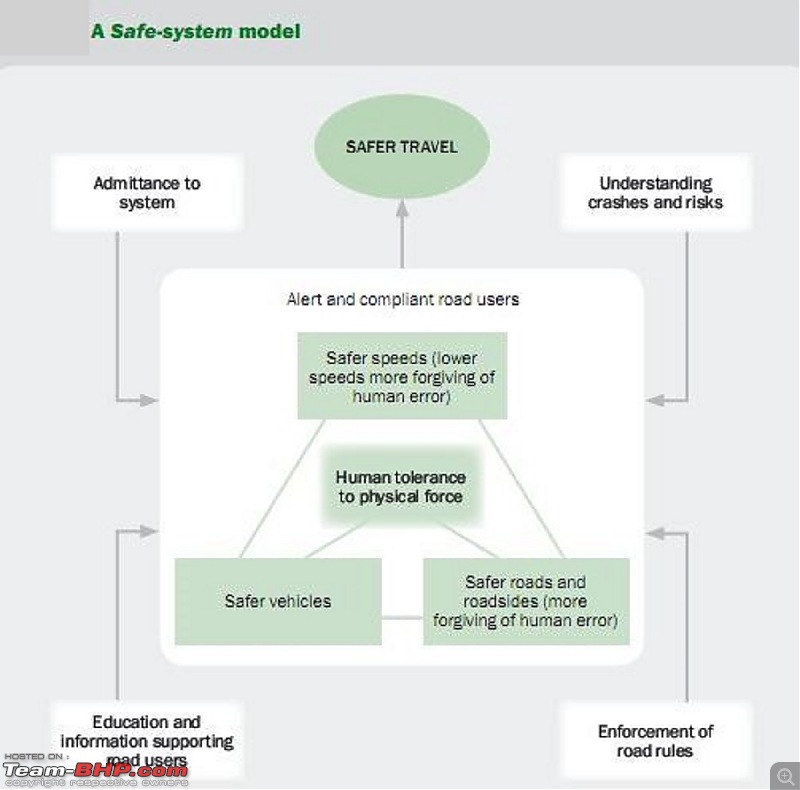 Last edited by SS-Traveller : 19th October 2019 at 08:27. |
| |  (21)
Thanks (21)
Thanks
 |
| The following 21 BHPians Thank SS-Traveller for this useful post: | BlackPearl, Blooming Flower, digitalnirvana, DriverWanderer, GeeTee TSI, GST, GTO, jailbird_fynix, N33raj, omranga98, RudiV3810, samaspire, Samba, siddarthab, sukiwa, tejas2323, Tgo, theexperthand, vb-saan, Vik0728, virgopal |
| | #6 |
| Distinguished - BHPian  | re: All about speeding, speed limits, and reasons & methods for setting speed limits How does India set the speed limits on its roads? To be honest, India does not use any scientific methods to set speed limits on our roads, whether urban roads, highways & expressways, or rural roads. ‘The variation in speed limits in NCR is bizarre’  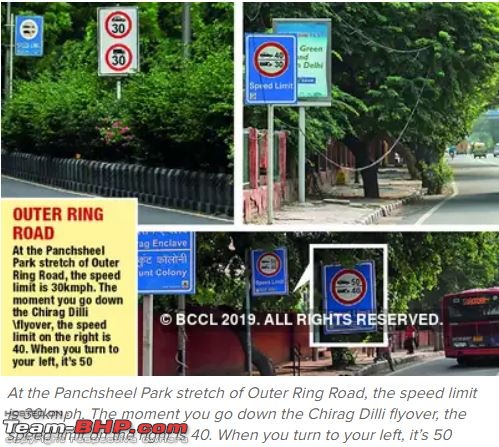  All new cars in India now have audible / visible speed warning systems at 80 kmph and 120 kmph, but not all roads are speed-limited for 80 / 120 kmph. Making variable speed limiters mandatory for every car would have helped more than the irritating beep that all new cars have. But when it comes to installing speed limiters in public vehicles, it is suggested that the condition of our roads can act as speed governors, and it is pointless to install such devices in vehicles anyway. Makes for the perfect excuse about continuing to have bad roads! Condition of Mumbai roads won't let vehicles exceed 80 kmph speed limit: Mumbai HC And then of course, there is a disconnect between posted speed limits and the speeds which are enforced: Reprieve on expressway: Why cops may waive some challans  For that matter, I have personally been a victim of this disconnect some years ago (Speed limits are... what Delhi Traffic Police personnel say (not what's published)). Last edited by SS-Traveller : 19th October 2019 at 17:06. |
| |  (19)
Thanks (19)
Thanks
 |
| The following 19 BHPians Thank SS-Traveller for this useful post: | BlackPearl, Blooming Flower, digitalnirvana, GeeTee TSI, GTO, jailbird_fynix, N33raj, omranga98, Rajeevraj, RudiV3810, Samba, sayakc, siddarthab, Tgo, theexperthand, vb-saan, Vik0728, virgopal, ysjoy |
| | #7 |
| Distinguished - BHPian  | re: All about speeding, speed limits, and reasons & methods for setting speed limits The case for and against Differential Speed Limits (DSL) A differential speed limit is defined as being one limit for automobiles and a different limit for commercial motor vehicles (“trucks”) whereas a uniform speed limit (USL) is defined as a single limit for cars and trucks. Because states enact differential speed limit (DSL) solely in order to improve safety, assessment of DSL’s safety impacts is of significant importance to the transport community. Given size and weight differences between cars and trucks and special manoeuvrability characteristics associated with these two types of vehicles, uniform speed limits may be inappropriate to account for all potential safety problems. Recognizing the more restrictive manoeuvrability of large trucks, differential speed limit (DSL) strategies are used to address this issue. India follows a Differential Speed Limit (DSL) pattern for all its roads, wherein heavy vehicles (trucks and buses) have a speed restriction of 40-60 kmph, two-wheelers have a maximum allowed speed limit of 50 kmph, and LMVs can travel at the posted maximum speed limit for that road, which can be even 60 kmph higher than the speed limits for trucks. However, there is no documented research or evidence to prove whether DSL actually helps to reduce crashes. Government crash data point to the fact that 61% of vehicular accidents involve vehicles that are governed by DSL (two-wheelers: 34%; goods carriers: 20%; buses: 7%):  It remains to be researched whether following DSL on Indian roads actually leads to reduction of casualties, but given the erratic driving pattern and poor driver training of our commercial HTV drivers, and generally poor maintenance of our buses and trucks, it would not be a good idea to permit high speeds such as 100 kmph for trucks & buses that the government & NHAI propose. Last edited by SS-Traveller : 19th October 2019 at 13:51. |
| |  (16)
Thanks (16)
Thanks
 |
| The following 16 BHPians Thank SS-Traveller for this useful post: | BlackPearl, Blooming Flower, Burn_out, digitalnirvana, GeeTee TSI, GTO, jailbird_fynix, N33raj, Samba, siddarthab, tejas2323, Tgo, The Rationalist, theexperthand, vb-saan, Vik0728 |
| | #8 | |
| Distinguished - BHPian  | re: All about speeding, speed limits, and reasons & methods for setting speed limits So why is India cracking down on speeding (and other traffic violations) now? Data available in the public domain from 2017 shows that speeding (or over-speeding, sic) is, by and large, the biggest reason for accidents on Indian roads, with the highest number of fatalities and casualties compared to any other cause. 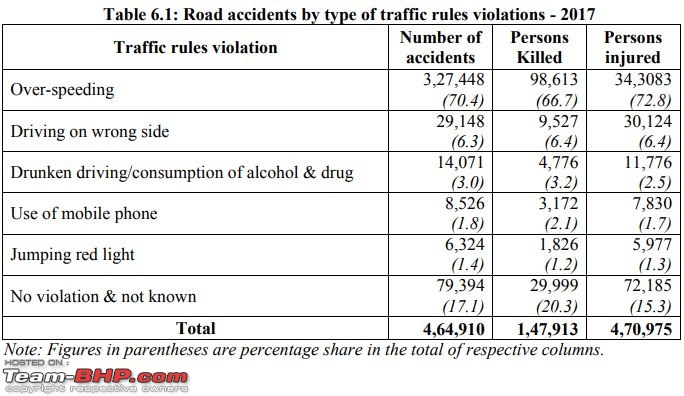 In 2015, India, as a signatory to the Brasilia declaration, has declared that it intends to reduce road accidents and traffic fatalities by 50% by the year 2022 (originally 2020). Quote:
With the amended MV Act having come in only in September 2019, it remains to be seen over the next few years whether the targeted reduction in road fatalities actually happens. How successful we shall be in halving our deaths on the road in the next 3 years, only time will tell. Till then, drive just a little slower, drive with a lot more discipline & concentration, drive safe, and stay alive and healthy. Last edited by SS-Traveller : 19th October 2019 at 17:11. | |
| |  (44)
Thanks (44)
Thanks
 |
| The following 44 BHPians Thank SS-Traveller for this useful post: | abhishek46, ais, avis4398, avishar, BlackPearl, Blooming Flower, dealer, Desmosedici, digitalnirvana, DriverWanderer, Gaboonviper04, GeeTee TSI, GTO, Hayek, icar, jailbird_fynix, mallumowgli, N33raj, nalinsaxena23, Nempuguru, NomadicLife, omranga98, PM - B, psispace, puneetakhouri, racer_ash, Rajeevraj, samaspire, Samba, sayakc, siddarthab, SLK, spgv, sudeepg, tejas2323, Tgo, The Rationalist, theexperthand, TSIboy, Vasuki, vb-saan, Vik0728, virgopal, ysjoy |
| | #9 |
| Team-BHP Support  | re: All about speeding, speed limits, and reasons & methods for setting speed limits Note from Moderator Excellent compilation - Thanks for sharing Moving to the Safety Section |
| |  (7)
Thanks (7)
Thanks
 |
| The following 7 BHPians Thank ajmat for this useful post: | ais, avishar, digitalnirvana, GTO, samaspire, SS-Traveller, virgopal |
| | #10 |
| Team-BHP Support  | re: All about speeding, speed limits, and reasons & methods for setting speed limits Excellent thread SS da with exceptional details. Went through all of it at one go. Rated 5 stars. Discipline, concentration and empathy for other road users are the most important points to follow from a driver’s point of view. |
| |  (3)
Thanks (3)
Thanks
 |
| The following 3 BHPians Thank BlackPearl for this useful post: | digitalnirvana, siddarthab, SS-Traveller |
| | #11 |
| Senior - BHPian Join Date: Feb 2004 Location: DL XX XX XXXX
Posts: 1,634
Thanked: 1,011 Times
| re: All about speeding, speed limits, and reasons & methods for setting speed limits Excellent topic and so close to my heart. People from Delhi would see the recent trend in installing speed cameras almost everywhere, there are 100s now. So in Delhi, unless you are absolutely sure, there is no camera on a particular stretch of road or your car is registered in another state or your number plate is deliberately kept dirty, you can't over-speed! I'm sure, we are going to have a very interesting discussion here, but a few things should be added here.
As far as statistics go, in a country where we can't even take a count of how many rapes are actually reported, accidents due to over-speeding is in most cases is a figment of imagination of the bystanders. Also, what the statistics don't tell if the fatal accidents actually happened when someone was doing 100/150+ kmph in city limits rather than 55kmph. While I agree that between 90 and 100 and 110 the risk of fatal accidents increase, the change in risk on a 6-8 lane road between 50 and 65 is insignificant (if you know Delhi roads). As for me, I comply with speed limits, almost always and now-a-days, I see my 180 bhp car being the slowest thing on the road. I drive through the Delhi ring-road everyday and with a speed-limit of 50kmph, somehow I'm the slowest and even buses overtake me. With less than 50% cars on the road which have local Delhi numbers or good clean number-plates, I feel disadvantaged to be able to even drive at the average speed of the traffic on a 6-8 lane road. For now, Delhi police is having a bumper time issuing automatic speeding challans at over the 50kmph speedlimits they have set for most of the 6 lane roads, they are actually so happy with the results of money pouring in, that speed cameras and their dedicated steel pillars are being put at an insanely fast pace. So much so that, unless speedlimits are rationally put-up, it is getting choking to drive for rules obeying people (all the time watching the rear of the car!) Another question, do people really know how fast are they going? at least as per this thread https://www.team-bhp.com/forum/india...driving-3.html (How often do you check the instrument cluster/MID while driving?) at least 15% of team-bhp members don't, leave alone many others who are not enthusiasts and drive by instincts. Last edited by SLK : 20th October 2019 at 01:00. |
| |  (9)
Thanks (9)
Thanks
 |
| The following 9 BHPians Thank SLK for this useful post: | digitalnirvana, DriverWanderer, GST, harry10, kutlee, Nitish.arnold, parth.jain, Shreyans_Jain, SS-Traveller |
| |
| | #12 |
| BHPian Join Date: Mar 2019 Location: Pune
Posts: 524
Thanked: 1,290 Times
| re: All about speeding, speed limits, and reasons & methods for setting speed limits Excellent thread SS Sir. Rated a well deserved 5 stars. It is really a wonderful compilation of the facts and the thinking behind enforcing Speed Limits on the roads worldwide. Unfortunately it is not so in India and the speed limits enforced are impractical and not well thought out. The Mumbai Pune Expressway speed limit was increased to 120 kmph and now again has been reduced back to the original 80 kmph. Some ghat sections have 30 kmph as the limit mentioned which is practically impossible and very few vehicles follow that. I try to go at a speed which is legal and have enough time to react in case something goes wrong. Also the people in the car should be comfortable at that speed. |
| |  (2)
Thanks (2)
Thanks
 |
| The following 2 BHPians Thank adi.mariner for this useful post: | DriverWanderer, SS-Traveller |
| | #13 |
| BHPian Join Date: Nov 2007 Location: jaipur
Posts: 199
Thanked: 786 Times
| re: All about speeding, speed limits, and reasons & methods for setting speed limits Thanks for a such a detailed explanation on speeding and its effects on road safety in the country. While i follow the speed limit judiciously, i always have this thought at the back of my mind that how does one enjoy a good performance/handling machine without speeding? As pointed out by other members of the forum, speed limits of 30-40 kmph are often imposed on various mountain roads and at those speeds i would argue that most cars would be indistinguishable in terms of performance or handling. How does one justify buying a high performance machine with such limits imposed? While few people in the country live in the vicinity of a racetrack to truly enjoy the potential of their car, most do not. So does this mean that someone lucky enough to purchase an expensive car, should only purchase luxury barges? As performance figures of cars if driven at speeds limits of 50-80 kmph are of no significance. I hope fellow forum members would elaborate on how they were able to better enjoy their driving experience while following the speed limit. Note - In no way do i support or encourage speeding or any other form of unsafe driving and am fully in support of any steps taken to reduce road accidents and make our roads safer for one and all. |
| |  (1)
Thanks (1)
Thanks
 |
| The following BHPian Thanks dealer for this useful post: | SS-Traveller |
| | #14 |
| BHPian Join Date: Jul 2019 Location: New Delhi
Posts: 76
Thanked: 359 Times
| re: All about speeding, speed limits, and reasons & methods for setting speed limits Wonderful thread backed with data. Felt as if I was reading a research paper. I agree that speed is a major contributing factor for fatalities on the roads, but I think there is one more hidden reason behind speeding especially in our highways. Given the poor state of our roads, it is next to impossible to execute an interstate trip with proper timing. We get stuck at certain choke points en-route which wastes a lot of time. I have seen personal vehicle/government bus drivers get irritated because of this. In the end, drivers try to overcome the lost time by the only available option they have i.e.. speeding. I have been on trips that were supposed to last 3-4 hours but took 6-7 hours. Such long duration drives frustrates the bus drivers as they have a timetable to maintain. For the personal car drivers, this can be controlled to a certain extent by factoring in 2-3X delay depending on the roads. Be it a bus, a train or an aircraft, people actually credit the pilot/driver if he/she is able to recover the lost time due to a delay and reach the destination early. When a bus/car driver is given such a compliment, people don't realize that they are encouraging over speeding indirectly. While aircraft and trains have a dedicated path and slack time to recover the lost time, roads are totally different. In my view, along with over speeding, the stress levels of drivers also needs to be managed on Indian roads. One of the main reason for the stress is the bad condition of our roads. |
| |  (2)
Thanks (2)
Thanks
 |
| The following 2 BHPians Thank J4J for this useful post: | SS-Traveller, tejas2323 |
| | #15 |
| Distinguished - BHPian  | re: All about speeding, speed limits, and reasons & methods for setting speed limits Great initiative and a very informative thread. Gained a lot of knowledge on how things work. Rated 5*. Its sad, in India still the speed limits are not yet implemented by following the scientific way. In places i have seen the normal speed limit mentioned on NH is 80, then suddenly you will see a board with speed limit mentioned as 40 and policemen standing with a speed gun just after that! Do they want the motorists to brake that hard and come down from 80 to 40?  |
| |  (3)
Thanks (3)
Thanks
 |
| The following 3 BHPians Thank Samba for this useful post: | DriverWanderer, siddarthab, SS-Traveller |
 |

